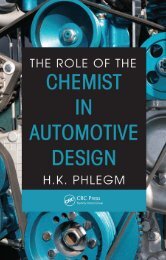Lightweight Electric/Hybrid Vehicle Design
Lightweight Electric/Hybrid Vehicle Design
Lightweight Electric/Hybrid Vehicle Design
You also want an ePaper? Increase the reach of your titles
YUMPU automatically turns print PDFs into web optimized ePapers that Google loves.
Introduction xv<br />
offsets the very high calorific value packed by a litre of petrol. An electric car has potential for<br />
very low cost per mile operation based on electrical recharge costs for the energy-storage batteries,<br />
and EVs are quite competitive even when the cost of battery replacement is included after the<br />
duration of charge/recharge cycles has been reached. It needs to be made apparent to the public<br />
that a change in batteries is akin to changing the cartridge in a photocopier–essentially the motiveforce<br />
package is renewed while the remainder of the car platform (machine) has the much longer<br />
life associated with electric-driven than does the petrol-driven vehicle. In this sense batteries are<br />
amortizable capital items, to be related with the much longer replacement period for the vehicle<br />
platform which could well carry different style bodies during its overall lifetime.<br />
The oversizing of petrol engines in conventional cars, referred to above, arises from several<br />
factors. Typical car masses, relative to the masses of the drivers they carry, mean that less than 2%<br />
of fuel energy is used in hauling the driver. Added to the specifying of engines that allow cars to<br />
travel at very large margins above the maximum speed limit is of course the conventional<br />
construction techniques and materials which make cars comparatively heavy. The weight itself<br />
grossly affects accelerative performance and gradient ability. Also some estimates consider six<br />
units of fuel are needed to deliver one unit of energy to the wheels: one-third wheel power being<br />
lost in acceleration (and heat in consequent braking), one-third in heating disturbed air as the<br />
vehicle pushes through the atmosphere and one-third in heating the tyre and road at the traction,<br />
braking and steering contact patch. This puts priorities on design for electric vehicles to cut tare<br />
weight, reduce aerodynamic drag and reduce tyre rolling resistance.<br />
0.2.3 QUESTIONING THE INDUSTRY-STANDARD APPROACH<br />
The design process in the main-line automotive industry is driven by the edicts of the car-makers’<br />
styling departments who ultimately draw their inspiration from the advertising gurus of Madison<br />
Avenue, whose influence has, of course, spread worldwide. The global motor industry has been<br />
predominately US dominated since Henry Ford’s pioneering of systematic volume production<br />
and General Motors’ remarkable ability to appeal to widely different market sectors with quite<br />
modestly varied versions of a standard basic vehicle. Thus far the electric, or hybrid drive, vehicle<br />
had to conform to historically developed design norms with the cautious conservatism of marketing<br />
management defining the basic scantlings. Conventional automotive design must conform to the<br />
requirements of Mr and Mrs Average, analysed by countless focus groups, while meeting the<br />
necessities of mass-production equipment developed during the first century of the motor vehicle.<br />
When bold attempts have been made to achieve substantial reductions in weight below that of<br />
the standard industry product, the limitations of these major constraints have usually moderated<br />
the design objectives, Fig. 0.1. The overruling necessity to ‘move metal’ at the scale of ten million<br />
vehicles per year from each of the world’s three main areas of motor manufacture makes radical<br />
design initiatives a scary business for ‘corporate bosses’. Advertising professionals, with their<br />
colleagues in public relations, have skilfully built up customer expectations for the conventional<br />
automobile, from which it is difficult for the designer to digress in the interests of structural<br />
efficiency and light weight. Expectations are all about spacious interiors with deep soft seats and<br />
wide easy-access door openings; exterior shape is about pleasing fantasies of aggressiveness,<br />
speed and ‘luxury’ appearance. Performance expectations relate to accelerative ability rather than<br />
fuel economy, as Mr Average Company Representative strains to be ‘first off the grid’.<br />
Ecologists who seek the palliative effects of electric propulsion will need to face up to educating<br />
a market that will appreciate the technology as well as convincing motor industry management of<br />
the need for radical designs which will enable the best performance to be obtained from this<br />
propulsion technology. The massive sensitivity of the general public to unconventional vehicle







